The world of purple parrot species is full of breathtaking beauty, rarity, and vibrant colors that captivate bird lovers. These exotic birds stand out with their striking plumage, making them some of the most unique and visually stunning creatures in the avian world. Whether they display deep violet feathers, subtle purple hues, or a dazzling mix of colors, these parrots never fail to impress.
Many of these birds thrive in tropical regions, from the lush rainforests of South America to the dense jungles of Asia and Africa. Their bright feathers help them blend into the rich colors of their natural habitat while also playing a role in attracting mates. Some species, like the Hyacinth Macaw, dominate the skies with their powerful wings and bold colors, while others, like the Violet-Necked Lory, showcase a more delicate and playful charm.
Beyond their beauty, these parrots possess remarkable intelligence, strong social instincts, and, in some cases, excellent talking abilities. While some species can live happily as pets with proper care, others remain best admired in the wild due to their specific dietary needs and conservation concerns. In this blog post, you’ll discover seven of the most breathtaking purple parrot species that every bird enthusiast should know.
The Beauty of Purple-Feathered Parrots
Why Purple Parrots Stand Out in the Avian World
Purple parrots command attention with their rich, vibrant plumage that sets them apart from more common green, red, or blue parrots. Their striking coloration makes them rare gems in the bird world, often becoming the focal point in aviaries, sanctuaries, and the wild. Unlike many other parrot species, which rely on shades of green to blend into dense forests, purple parrots showcase a bold and exotic look that instantly captivates bird enthusiasts.
Beyond their colors, these parrots display intelligence, playfulness, and social behavior that make them fascinating creatures. Some species, like the Hyacinth Macaw, form deep bonds with their flock members or human caretakers, while others, like the Violet-Necked Lory, use their acrobatic skills to entertain observers. Their combination of beauty and personality makes them some of the most admired parrots among bird lovers.
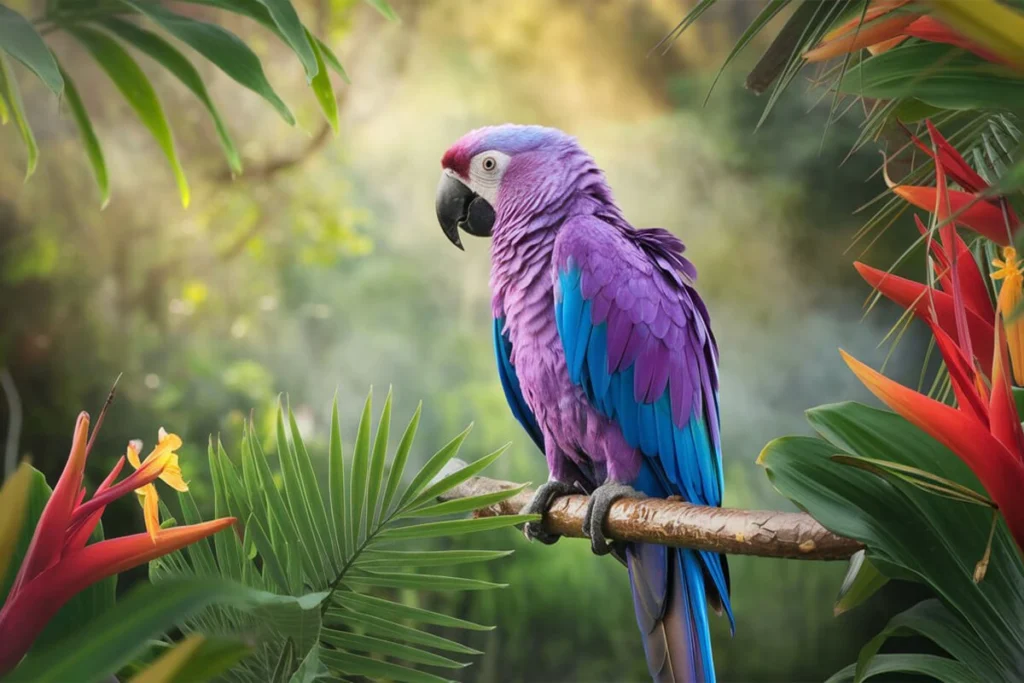
The Significance of Vibrant Plumage in Nature
A parrot’s bright plumage isn’t just for show—it plays a crucial role in survival, communication, and reproduction. In the wild, these dazzling colors help attract mates during breeding seasons. A parrot with more intense and well-maintained feathers often signals good health and strong genetics, making it a desirable partner.
In addition to courtship, their bright feathers serve as a form of camouflage in certain environments. While this may seem counterintuitive, many tropical forests burst with colorful plants, flowers, and fruits. A purple-feathered bird can blend into the multicolored landscape, helping it evade predators.
For some species, vibrant colors act as a warning signal. The Pesquet’s Parrot, also known as the Dracula Parrot, sports a dramatic mix of black and red feathers that create an intimidating appearance. This bold look may help deter potential threats by signaling that the bird is not an easy target.
How Rare and Unique These Birds Are Compared to Other Colorful Species
Purple parrots rank among the rarest birds in the world. While red, green, and blue parrots dominate most tropical regions, finding a species with deep purple hues is far less common. Many of these birds live in isolated rainforests or specialized environments, limiting their population size and making sightings even more special.
Unlike common pet parrots like Budgerigars or Cockatiels, these exotic species often have strict habitat requirements and unique dietary needs. Some, like the Violet-Necked Lory, rely on a nectar-rich diet, while others, like the Hyacinth Macaw, need specific nuts that grow only in certain regions of South America. This exclusivity adds to their mystique and makes them even more desirable to bird enthusiasts.
Despite their rarity, conservation efforts have become crucial to protecting these birds from habitat destruction and illegal pet trade. As deforestation continues to threaten tropical regions, some species face population decline, making it even more important to raise awareness and support preservation efforts.
These incredible traits—vibrant colors, unique behaviors, and limited populations—make purple parrots some of the most extraordinary birds on the planet. Their rarity and beauty ensure they remain a treasured part of the natural world.
7 Stunning Purple Parrot Species You Must See
1. Hyacinth Macaw
The Hyacinth Macaw reigns as the largest flying parrot, showcasing a breathtaking deep blue-purple hue that appears almost iridescent under sunlight. This majestic bird measures up to 40 inches (1 meter) long, making it an impressive sight in the wild. Its powerful black beak, capable of cracking open tough nuts, stands out against the yellow markings around its eyes and lower mandible.
Hyacinth Macaws thrive in the tropical rainforests of South America, particularly in Brazil, Bolivia, and Paraguay. These intelligent birds often form strong bonds with their mates, displaying affectionate behavior such as preening and vocalizing softly to each other. They rely on specific palm nuts for sustenance, especially those from the acuri and bocaiuva palms.
Due to habitat destruction and illegal pet trade, their population has declined over the years. Conservation programs now focus on protecting their natural environment and regulating trade to prevent further loss of these magnificent parrots.
2. Violet-Necked Lory
The Violet-Necked Lory stuns observers with its small yet striking appearance. Its deep violet neck and chest contrast beautifully against its bright red and green wings. This parrot, native to the rainforests of Southeast Asia, particularly in Indonesia and Papua New Guinea, thrives in humid, tropical environments.
Known for its energetic and playful nature, this lory spends most of its time hopping between trees, searching for nectar, fruits, and pollen. Unlike many parrots that prefer seeds, the Violet-Necked Lory possesses a specialized brush-tipped tongue that allows it to feed on flower nectar efficiently.
This highly social bird often lives in pairs or small flocks, chattering loudly as it flits between the treetops. Bird enthusiasts admire its intelligence and friendly demeanor, making it a favorite in aviaries where proper diets and space accommodate its active lifestyle.
3. Pesquet’s Parrot (Dracula Parrot)
The Pesquet’s Parrot, often called the Dracula Parrot, stands out with its eerie yet fascinating appearance. Its jet-black body, blood-red chest, and subtle purple sheen create an unmistakable look. Unlike other parrots, this species sports a nearly featherless head, resembling vultures rather than typical parrots.
Native to the mountainous rainforests of New Guinea, the Dracula Parrot relies on a diet of figs and soft fruits, making it a frugivore. Because of its fruit-based diet, it rarely damages crops, allowing it to coexist with local communities without conflict.
Unlike most parrots, Pesquet’s Parrot has weak feet and limited climbing ability, forcing it to rely heavily on its powerful wings for movement. Despite its fascinating traits, habitat destruction and illegal poaching threaten its population. Conservationists work to protect these unique birds from further decline.
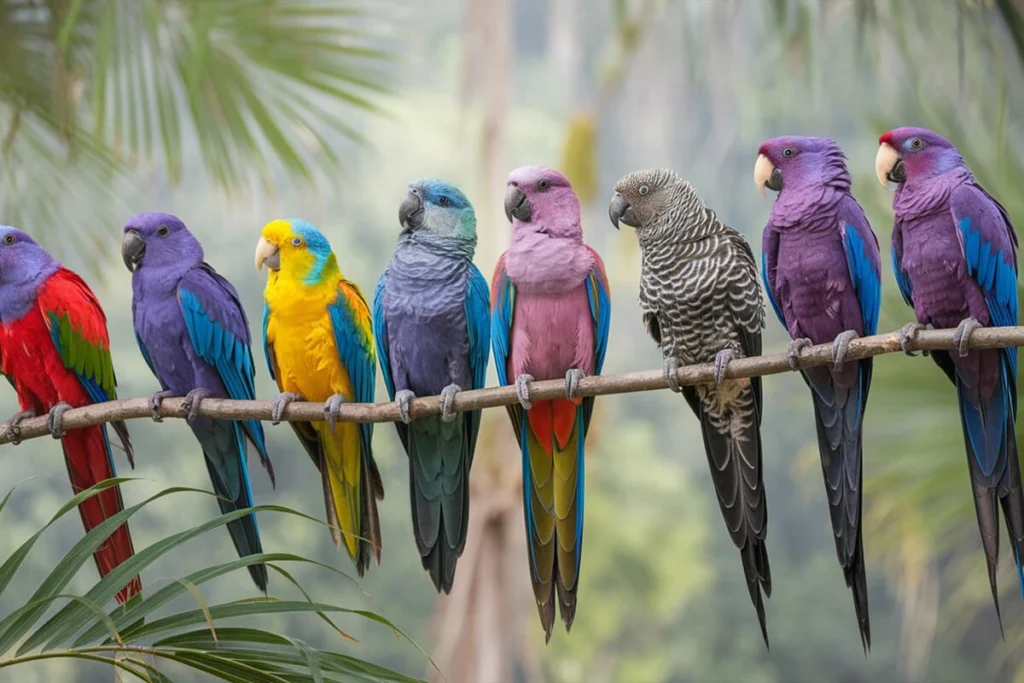
4. Plum-Headed Parakeet
The Plum-Headed Parakeet brings elegance and charm with its soft, pastel-like plumage. Males display a striking purple-pink head, while females have a duller, bluish-gray version. Their green bodies contrast beautifully with their head color, making them one of the most visually appealing parakeets.
These medium-sized parakeets thrive in the forests and woodlands of South Asia, particularly in India, Nepal, Bangladesh, and Sri Lanka. Unlike many parrots, they exhibit a relatively quiet nature, making them popular among bird enthusiasts who prefer less noisy companions.
Plum-Headed Parakeets live in flocks, soaring gracefully through open spaces in search of fruits, seeds, and blossoms. Their gentle and friendly temperament makes them easy to train, and they can develop a modest vocabulary when kept as pets.
5. Purple-Bellied Lory
The Purple-Bellied Lory captivates bird lovers with its vibrant colors. This small parrot features a deep purple belly, bright green wings, and a reddish-orange beak. The contrast between these hues makes it one of the most colorful lories in the avian world.
This species thrives in the tropical forests of Indonesia and surrounding islands, where it navigates dense vegetation in search of nectar, fruits, and pollen. Like other lories, it possesses a brush-like tongue that helps it efficiently extract nectar from flowers.
Purple-Bellied Lories exhibit high energy levels, constantly moving and exploring their surroundings. In captivity, they require plenty of space and enrichment activities to prevent boredom. Their lively and social nature makes them excellent aviary birds, though they need specialized diets to maintain their health.
6. Eclectus Parrot (Female Variants)
The Eclectus Parrot exhibits extreme sexual dimorphism, meaning males and females look entirely different. While males display bright green plumage, females boast a dramatic mix of red, blue, and deep purple feathers. This rare combination makes female Eclectus Parrots one of the most stunning birds in the parrot family.
Native to the rainforests of the Solomon Islands, Australia, and New Guinea, Eclectus Parrots prefer dense, tropical environments where they can find abundant fruits, nuts, and blossoms. Their strong beaks allow them to crack open tough seeds, ensuring they get proper nutrition.
Highly intelligent and capable of mimicking human speech, Eclectus Parrots make excellent companions when provided with proper care. Their ability to form strong emotional bonds with their owners adds to their charm, though they require a structured environment and mental stimulation to stay happy and healthy.
7. Blue-Crowned Hanging Parrot
The Blue-Crowned Hanging Parrot may not display an entirely purple body, but its subtle purple-blue crown gives it a unique and exotic look. This small, vibrant parrot sports a predominantly green body, accented by a bluish-purple patch on its head and a slight red mark on its chest.
Native to the forests of Southeast Asia, particularly in Thailand, Malaysia, and Indonesia, this parrot prefers a high canopy lifestyle. Unlike many parrots, it has a habit of sleeping upside down, earning it the name “hanging parrot.”
This species enjoys a diet rich in fruits, nectar, and flowers, frequently moving between trees to forage. Its quiet and calm nature makes it a suitable aviary bird, though it requires plenty of climbing opportunities and perches to mimic its natural habitat.
Where to Find These Exotic Purple Parrots
Natural Habitats
Purple parrot species thrive in some of the world’s most breathtaking and biodiverse regions. Many of these parrots prefer the dense rainforests of South America, Asia, and Africa, where they find food, shelter, and the perfect conditions for breeding. Tropical environments provide warm temperatures, high humidity, and an abundance of fruiting trees, making them ideal for these colorful birds.
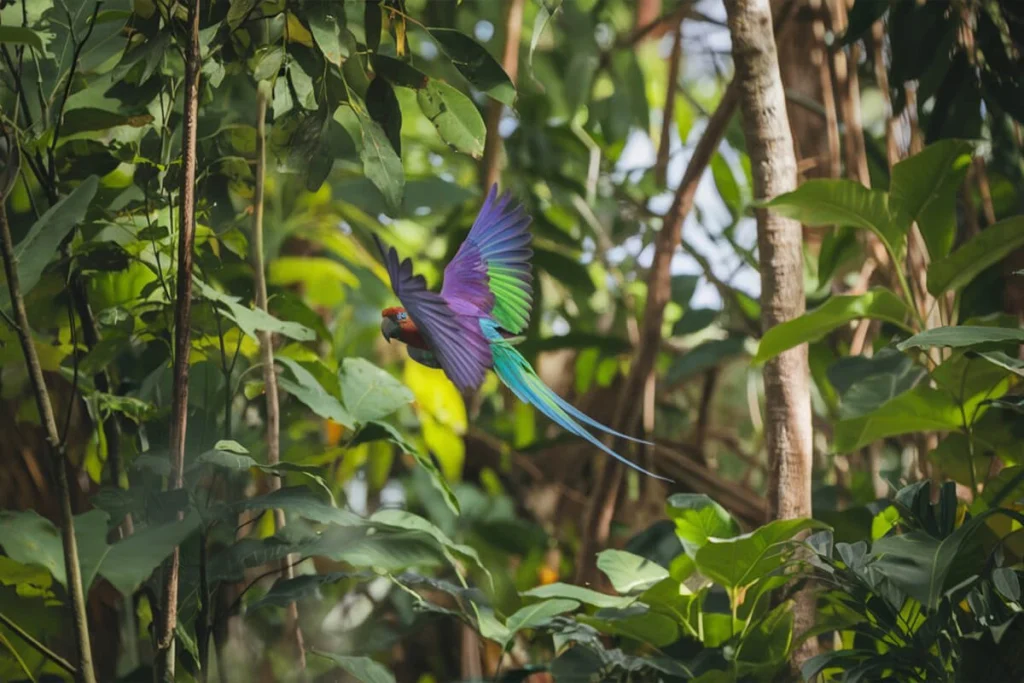
Some species, like the Hyacinth Macaw, inhabit the Amazon Basin and the Pantanal wetlands of Brazil, where they forage for palm nuts and interact with their flocks. Others, like the Violet-Necked Lory, soar through the treetops of Southeast Asia, flitting between tropical flowers to collect nectar. The Pesquet’s Parrot (Dracula Parrot) relies on the mountainous rainforests of New Guinea, where its specialized diet of figs dictates its limited range.
Despite their beauty, many of these birds face habitat destruction due to deforestation, agriculture, and urban expansion. As rainforests shrink, parrots struggle to find food, nesting sites, and safe migration routes. Conservationists work tirelessly to protect these environments, ensuring these stunning birds have a future in the wild.
Conservation Status of Rare Species
Many purple parrot species struggle to survive due to habitat loss, illegal wildlife trade, and climate change. The Hyacinth Macaw, once heavily trapped for the pet trade, now relies on conservation programs that protect its nesting sites and food sources. Though conservationists have helped increase their numbers in the wild, threats from deforestation and poaching still put them at risk.
The Pesquet’s Parrot (Dracula Parrot) faces a more urgent crisis. Hunters target this species for its striking black-and-red feathers, which fetch high prices in illegal markets. With its slow reproductive rate and limited habitat range, this parrot remains particularly vulnerable to population decline.
Other species, such as the Violet-Necked Lory and Purple-Bellied Lory, face threats due to illegal pet trade and deforestation. Logging and land conversion for agriculture destroy the very trees these birds depend on for food and shelter. Conservation organizations work to combat these threats by promoting breeding programs, habitat restoration, and stricter laws against wildlife trafficking.
Though some species, like the Plum-Headed Parakeet, maintain stable populations, continued deforestation and capture for the pet trade could change their conservation status in the future. Bird enthusiasts and conservation groups play a vital role in raising awareness and supporting efforts to protect these extraordinary parrots.
Captivity vs. Wild
The debate over keeping purple parrots in captivity sparks strong opinions among bird lovers. While some species adapt well to life in aviaries and homes, others require vast natural spaces to thrive.
Species like the Plum-Headed Parakeet and Eclectus Parrot adjust well to captivity when provided with proper care, space, and enrichment. Their social nature and ability to mimic human speech make them popular pets among bird enthusiasts. However, responsible ownership requires large enclosures, species-specific diets, and mental stimulation to keep them healthy and happy.
On the other hand, birds like the Hyacinth Macaw and Pesquet’s Parrot face significant challenges in captivity. The Hyacinth Macaw demands a diet rich in specialized nuts, which can be difficult to provide outside of its natural habitat. The Pesquet’s Parrot, with its unique fig-based diet, rarely thrives in captivity, making it unsuitable for the pet trade.
Illegal trapping for the exotic pet market remains a major threat to wild parrot populations. Many parrots suffer during capture and transportation, with a high mortality rate before they even reach buyers. Conservationists urge bird lovers to support ethical breeding programs and adopt parrots from reputable sources rather than contributing to illegal trade.
In the wild, these birds experience natural behaviors, strong flock bonds, and access to their native food sources, which ensures their well-being. Preserving their natural habitats remains the best way to protect them and maintain the balance of their ecosystems.
For those passionate about purple parrot species, supporting conservation efforts, educating others, and choosing ethical alternatives can make a difference. Whether admired in the wild or in responsible aviaries, these breathtaking birds deserve the best chance at survival.
Caring for a Purple Parrot as a Pet
Proper Diet
Providing the right diet for purple parrot species plays a crucial role in their health, longevity, and feather vibrancy. These birds require a balanced mix of fruits, vegetables, seeds, and protein sources, depending on their species.
Some parrots, like the Hyacinth Macaw, rely heavily on palm nuts, which supply essential fats and nutrients that keep their feathers in peak condition. Without access to these nuts, their health can decline rapidly. Other parrots, such as the Violet-Necked Lory and Purple-Bellied Lory, thrive on a nectar-based diet, requiring a constant supply of fresh flower nectar, pollen, and soft fruits like papayas, bananas, and mangoes. Their specialized brush-tipped tongues help them extract nectar efficiently, making them unique among parrots.
For parrot species that consume a broader range of foods, such as the Plum-Headed Parakeet and Eclectus Parrot, their diet should include leafy greens, sprouted seeds, nuts, and occasional sources of protein like cooked legumes or boiled eggs. Owners of pet parrots must avoid toxic foods like avocado, chocolate, caffeine, and high-sodium snacks, which can cause serious health issues.
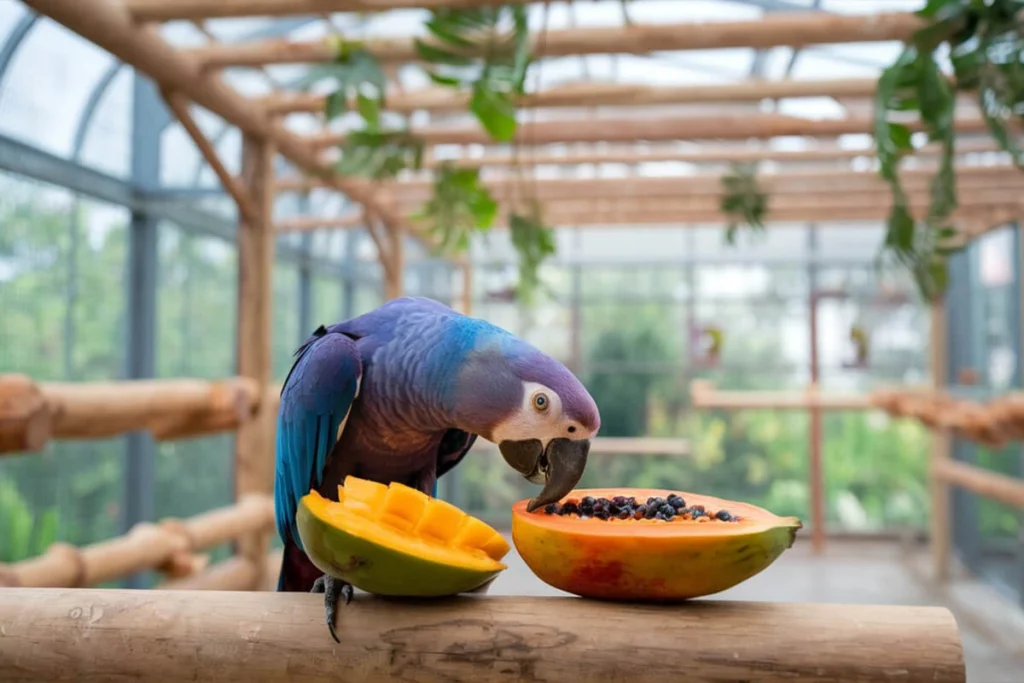
A poor diet leads to feather discoloration, low energy levels, and weakened immune systems, making proper nutrition a top priority for both captive and wild parrots.
Social Needs
Purple parrots thrive on interaction, whether with their flock in the wild or with human caretakers in captivity. These birds develop strong social bonds, making companionship an essential part of their well-being.
In the wild, many species, including the Hyacinth Macaw and Plum-Headed Parakeet, live in tight-knit flocks, relying on vocal communication and mutual grooming to strengthen relationships. These social behaviors help them navigate their environment, warn each other of predators, and find food sources together.
Parrots that live in captivity require just as much social interaction. Without mental stimulation and companionship, they become stressed, bored, and prone to feather plucking, aggression, and self-destructive behaviors. Owners should spend time talking, playing, and engaging with their birds daily. Providing a companion bird can also help meet their social needs, as many parrot species do better with a partner rather than living alone.
Highly intelligent species, like the Eclectus Parrot, require mental challenges such as puzzle toys, training sessions, and environmental enrichment to prevent boredom. Social engagement keeps them emotionally balanced and mentally sharp.
Neglecting a parrot’s social needs can lead to emotional distress, making it crucial to provide a stimulating and interactive environment.
Ideal Living Conditions
Creating the right living environment ensures that purple parrot species stay healthy and happy, whether in the wild or in captivity. These birds require spacious enclosures, proper perching areas, and exposure to natural sunlight to maintain their well-being.
Wild purple parrot species flourish in lush rainforests, tropical regions, and open woodlands, where they can fly freely, forage for food, and interact with their flock members. Preserving these natural habitats remains critical for their survival.
For purple parrot species kept as pets or in aviaries, an expansive cage or flight enclosure allows them to move freely and exercise their wings. Small cages restrict movement, leading to muscle atrophy and behavioral problems. Ideally, the enclosure should be wide enough for the bird to fully extend its wings and tall enough to allow climbing and exploration.
Proper perches, such as natural wood branches, help strengthen their feet and prevent pressure sores. Access to safe chew toys, climbing ropes, and swings encourages activity and prevents boredom.
Temperature and humidity also play a crucial role in their health. Since most purple parrot species come from warm, humid climates, they need a temperature range of 65–85°F (18–29°C) and a humidity level that mimics their native environment. Dry air can cause feather damage and respiratory issues, so misting or a humidifier may be necessary in drier climates.
In addition, these birds need exposure to natural or full-spectrum lighting to maintain their circadian rhythms and vitamin D levels. Lack of proper lighting can lead to weakened bones, poor feather quality, and mood imbalances.
Whether living in the wild or in captivity, purple parrot species require a safe, enriched, and spacious environment to thrive. Keeping them healthy involves meeting their dietary, social, and environmental needs, ensuring they remain vibrant and full of life.
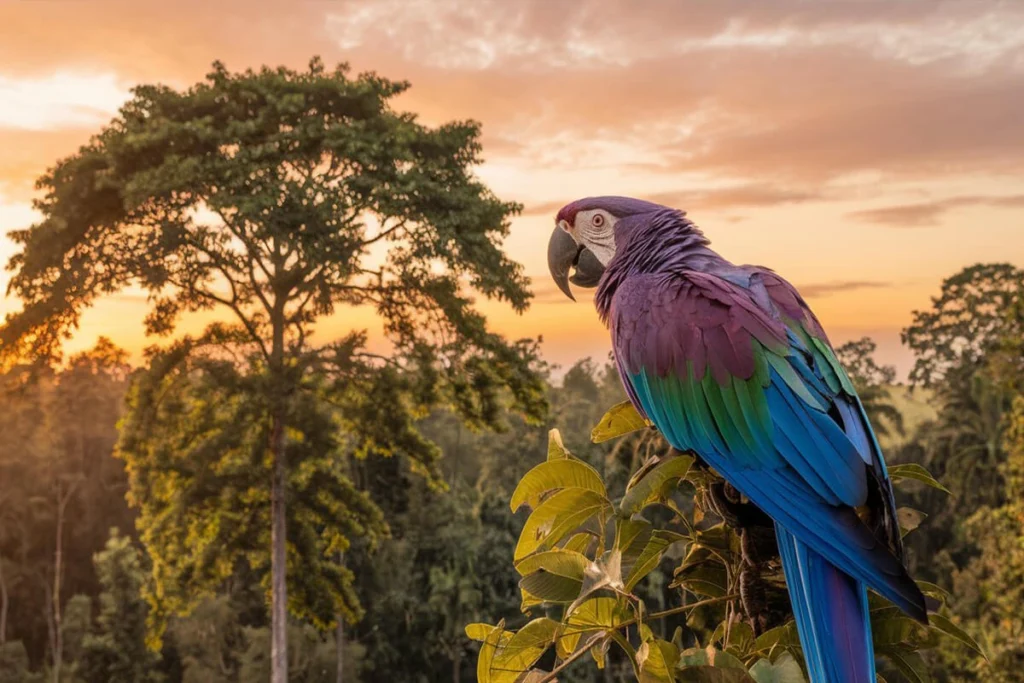
Conclusion
Purple parrot species stand out as some of the most breathtaking and unique birds in the avian world. Their vibrant plumage, intelligence, and social nature make them fascinating creatures, whether admired in the wild or responsibly cared for in captivity. From the majestic Hyacinth Macaw to the mysterious Pesquet’s Parrot (Dracula Parrot), these birds captivate bird lovers and conservationists alike.
Unfortunately, many of these stunning parrots face serious threats, including habitat destruction, illegal pet trade, and climate change. As rainforests disappear, wild populations struggle to find food, nesting sites, and safe environments to thrive. Some species, like the Hyacinth Macaw, have seen population recoveries thanks to dedicated conservation efforts. However, others, such as the Pesquet’s Parrot, remain at risk due to continued poaching and habitat loss.
For those passionate about purple parrots, supporting ethical breeding programs, conservation organizations, and responsible pet ownership plays a vital role in their survival. Choosing not to support the illegal wildlife trade helps keep these exotic birds where they belong—soaring freely in their natural habitats.
Whether observing these parrots in the wild, visiting reputable sanctuaries, or caring for them as pets, enthusiasts must prioritize their well-being, dietary needs, and social engagement. By educating others about their beauty and challenges, bird lovers can contribute to their protection and ensure future generations can admire these rare and striking birds.
The world of purple parrot species remains as extraordinary as it is fragile. With continued conservation efforts and responsible stewardship, these birds can continue to thrive and inspire awe in bird lovers around the globe.
Discover 10 Amazing Facts About the Purple Parrot You’ll Love
Find Some Useful Stuff For you Pet On PetMD Official
Get Helpful Tips for your pet Here
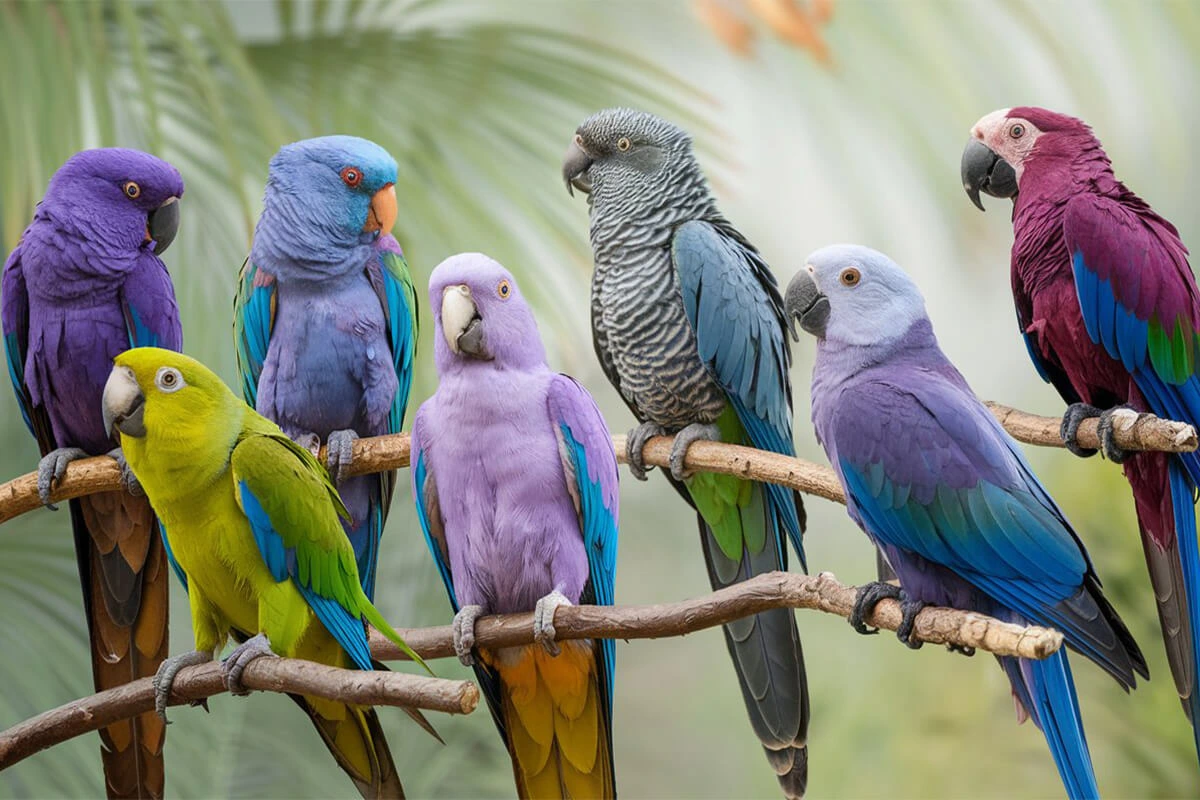
1 thought on “Top 7 Breathtaking Purple Parrot Species You Need to Know”
Comments are closed.